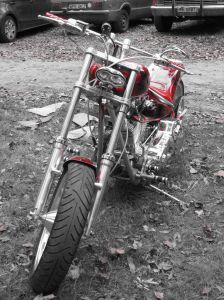 There is a huge misconception in this country when it comes to motorcycles. Riders, not known to be notoriously gullible, are often all too willing to believe that the shape and size of their tires will keep them safe on wet, slick roads. Yet, hydroplaning is as much a concern (if not more so) for bikers. While these tires are built to shed water quickly, thereby reducing the risk of losing contact with the road, they are not perfect and wear down just as any other tire would.
There is a huge misconception in this country when it comes to motorcycles. Riders, not known to be notoriously gullible, are often all too willing to believe that the shape and size of their tires will keep them safe on wet, slick roads. Yet, hydroplaning is as much a concern (if not more so) for bikers. While these tires are built to shed water quickly, thereby reducing the risk of losing contact with the road, they are not perfect and wear down just as any other tire would.
Hydroplaning on a motorcycle is extremely dangerous, as one might assume. When the driver can no longer control the two-wheeled vehicle, it is prone to slide, flip, or careen off the road. In any of these situations, the driver is at substantial risk of losing his or her life. To make matters worse, if the hydroplaning leads to others being injured, the biker could land himself before a personal injury attorney, judge, and jury.
To prevent this, a biker should be aware of red flags that can point to a danger of hydroplaning. These include improper tire pressure, excessive speed, standing water on the road, and slippery turning.
Improper PSI. It can happen on any vehicle and is never a good thing. A tire can begin to deteriorate or have a defect that causes it to lose air pressure. In other instances, a Saint Petersburg mechanic or the driver himself can accidentally overfill the tire. In either instance, there is an increased risk of hydroplaning. One relies on a good level of friction between the road’s surface and the tires. When the tire pressure isn’t quite right and water is not being shed properly, that contact can be lost.
Slow Down! Whenever the road conditions are not ideal – whether it be the result of blinding sun, loose gravel, rain, sleet, snow, or some other unexpected obstacle – it is wise to slow one’s speed. The faster that you are traveling on a wet road, the more likely you are to hydroplane because the tires cannot shed the water fast enough. It is especially important to slow before turns. Braking is an issue whenever riding on wet roads. Braking suddenly leaves you prone to hydroplaning because the wheels stop spinning and the tread is no longer displacing the water. If you must slow to make a turn or avoid an obstacle, don’t brake hard. Instead, hold on and let go of the brake over and over again until you have slowed enough.
Stay Away from Standing Water. In St. Petersburg, rain is almost a guarantee at certain times of the year, so you have to expect that the roads will get wet from time to time. If you can get off the road during inclement water or when there is standing water present, do so. It is always safest to avoid the risk altogether. If you must stay on the road, keep your eyes peeled for low points in the road’s surface that might contain large puddles of standing water. These are the areas that are most likely to cause you to lose control of your motorcycle.
If you do find yourself in a hydroplaning situation, do not panic. This is the worst thing that you can do. You must stay calm for the best chances of getting out of the condition without being harmed. Let off the accelerator, but do not attempt to brake. Focus your efforts on allowing the bike to slow itself, while you manage the steering to keep it on the road. To slow more rapidly, follow the braking pattern outlined above. Hard braking will make the situation much worse.
If you are injured on your motorcycle, seek medical help immediately, and contact Herman & Wells to discuss your case with a personal injury attorney.
